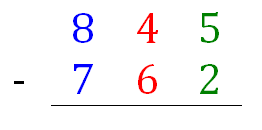An Alternative Algorithm for Subtraction
In the previous posts, I have shared to you an alternative algorithm for multiplication and division. In this post, I am going to share with you a different algorithm for performing subtraction. This algorithm does not involve “borrowing” from a higher place value but subtracts individual digits. To illustrate this algorithm, let’s consider some examples.
Example 1: 847 – 728
First, we separate the digits of the numbers as shown below.
Second, we subtract the corresponding digits. » Read more
